
4-6 June 2018
Legend has it that a few thousand years ago, somewhere in China, a cocoon fell from a tree into a hot cup of tea. Legend has it that the person holding the cup of tea was an empress, and that she had an interest in weaving. She noticed that the hot liquid melted the hard outer covering of the cocoon revealing a filament. Filaments are something that could possibly be woven into cloth, and it turned out that this was the case. Thus silk, that most glorious of fabrics, was both discovered and invented.
Legend has it that in 2732 B.C. Emperor Shen Nung discovered tea when leaves from a wild tree blew into his pot of boiling water. The resulting brew had a pleasant scent so he tried a little of it. And then a little more. As it filled him with warmth he felt as if the liquid was examining every part of his body. He named the brew ch’a, the Chinese word meaning to scrutinize or investigate.
Whether or not either of these legends are true we have a lot to thank the Chinese for. A few thousand years ago tea, like silk, was both discovered and invented in China. It seems that whenever something there falls from a tree into hot liquid a world-changing discovery follows. For centuries China was the only exporter of tea to the world, and to this day it is still the biggest producer of tea.
We are kitted out with a coolie hat and a basket and shown the way to the undulating rows of tea plants. There we are instructed in the fine art of tea picking; pick only the tiniest new leaves. It’s painstaking work. I can’t imagine the time it would take to fill one of the small plastic baskets we’re given, let alone one of the larger baskets normally used.
Tim and Belinda are the most successful.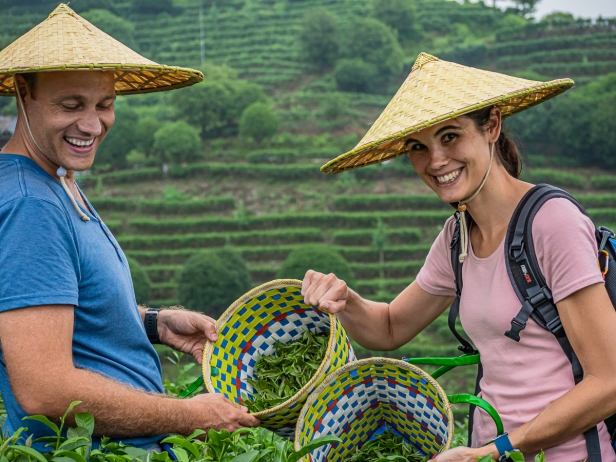
There are a couple of women working in the fields,

and a couple of other tourists, but it’s mostly just us in this glorious setting a few kilometres outside of Yangshuo Town.
For about 4000 years all tea was green tea. In the mid 17th century black tea was invented using a special fermentation process to help preserve the leaves for foreign trade. Black tea keeps its flavour and aroma longer than the more subtle green teas and so was better suited for the long voyages to other parts of the world.
All true teas come from the same plant: the young leaves and leaf buds of the camellia sinensis bush. Black tea leaves are fermented for two or three days, oolong leaves for a few hours, green tea not at all. White tea is harvested when the flower buds are still covered by thin white hairs. Like green tea it is not fermented.
After a while we take our haul into the tasting room and sample a few different brews

while a young man spends a long time sifting and rolling the tealeaves by hand.
It’s one of the processes in the production of tea. They are rolled until they begin to darken and turn red, though of course in the factories it is not done by hand, then they are spread out to ferment.
Being an Aussie of British heritage I was raised in the British tradition of making tea. Heat the pot. Drain the hot water out of the pot and put in a teaspoon of black tea for each cup, and one more for the pot. Pour on boiling water and allow it to steep for a few minutes. Always pour the milk into the cup first, and then add the tea and some sweetener if desired.
It took the Brits, and those of us of British heritage, years to accept teabags, and I still can’t stand tea that’s made with water that is less than boiling. Hot water won’t do; it has to be boiling. To this day I’m appalled by cafes that serve you a tea bag sitting on the saucer next to a cup of hot water.
I’m convinced the British Empire would never have existed without tea. It’s still considered the remedy for all that ails you. Everything can be fixed with a good hot cup of tea.
Except perhaps Brexit . . . . .
The tea plantation is a few kilometres outside of Yangshuo Town. Since the 1980’s the town has been a tourist mecca because of it’s location in some of the most spectacular scenery in the world, and for outdoor activities such as cycling, rock climbing, and hiking, but the town itself is worth a mention.
Of course there is backpacker central, the infamous West Street where east meets west
and where there are restaurants, internet cafes, hostels, bars, shops, tour operators, and a McDonalds. Incongruously there is also a wax museum featuring at the entrance such enticing characters as Mr Bean, a sleeping attendant, and two exquisitely beautiful western-looking women in long red cheongsams who take turns gracefully bowing. I stare for a long while trying to determine if they are real or not. Still, it’s not enough to entice me in.
Even in West Street you can’t escape the remarkable setting.
The town is surrounded by karst mountains, and bordered by the Li River, and the rural setting helps it retain a small-town feel. It feels a bit like a holiday town, and to people like me that’s exactly what it is. However some of the old ways still exist. They are seen occasionally on the main road,
and on the tourist streets juxtaposed against the relentless influence of the western world,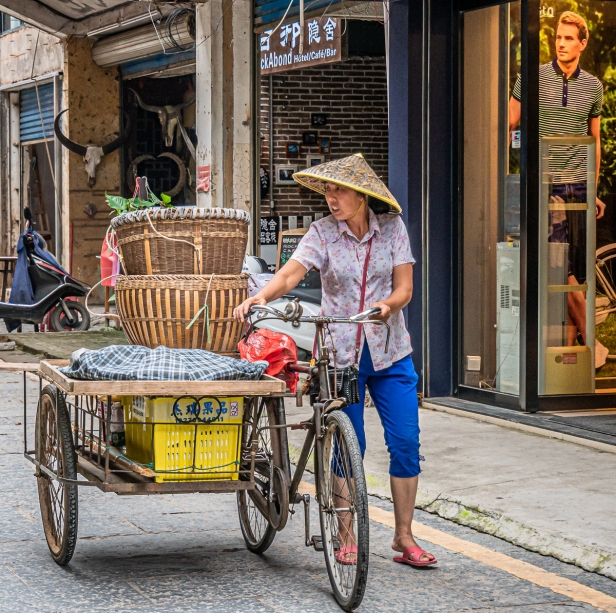
and leading off from West Street I find this: HOtel a street of Local Style Dwelliny Houses in the West Street. Trying to make some money by enticing visitors to a more authentic experience perhaps.
In the side streets and alleyways there is a town where ordinary people living ordinary lives go about their business.


Yangshuo is not like other Chinese cities. The quite big ex-pat community and the large influx of western visitors wanting to explore the extraordinary countryside brings a cultural richness and certain amount of wealth to the area, but as I explore deeper into the town I discover it has not lost its sense of self.
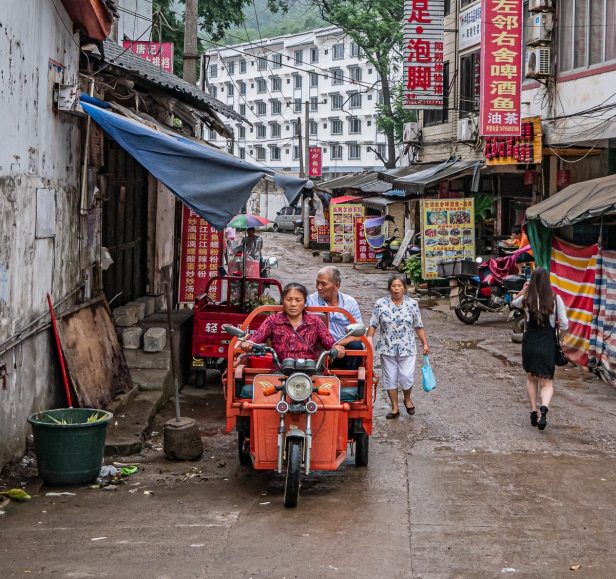

People still set up shop at the side of the road,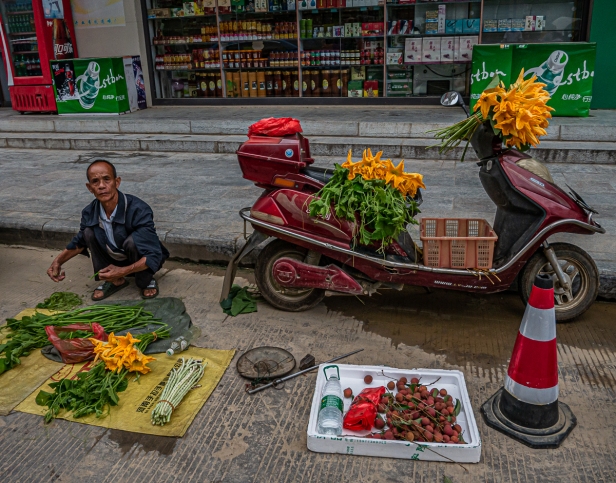


or find a quiet corner to have their fortune told (at least I think that’s what it is).
On the other hand, on West Street, I come across a photo shoot. There is prosperity in China these days, and a huge middle class, and like the rest of us they are being sold a bill of goods. You too can have a rich glamorous lifestyle if you buy this beverage.
I find my way to the Peoples’ Park, always one of the best places to intermingle with local life in China. Every town and city I went to had a vibrant and busy Peoples’ Park and in Yangshuo it’s no different. There are of course several groups of card players
but it’s the music I’m pulled by. There’s a drummer, and three erhu players.
The drum kit is a priceless contraption of home-made ingenuity with a wooden stand, a mechanism operated by foot pedals to play a pair of cymbals and a big copper disk, and a couple of round skin-covered drums on top.
Their enthusiasm is contagious and there’s a large crowd gathered around them. But what really attracts the crowd along with the musicians is the women singing. And singing well! Mostly it’s this woman
and she’s having a blast! From time to time a couple of other women join her in turn and they sing a duet, but it’s mostly the lady in red floral and white lace with her little hand-held microphone that has the crowd captured. This is so typical of the parks in China – people get out and have fun doing what they love to do. It’s spontaneous and impromptu and there for all to enjoy.
It’s about a forty-minute climb from the park to the top of Antenna Hill for the best view of the town. What a place to live!
There are so many great places to eat in Yangshuo, with cuisine from all over the world, but two nights in a row I’m so exhausted I get take-out noodles here,
a little pop-up restaurant on the sidewalk at the end of the street where our hotel is located.
Eight kilometres from Yangshuo town, surrounded on three sides by mountains, and on the fourth by the Li River, is the ancient village of Fu Li.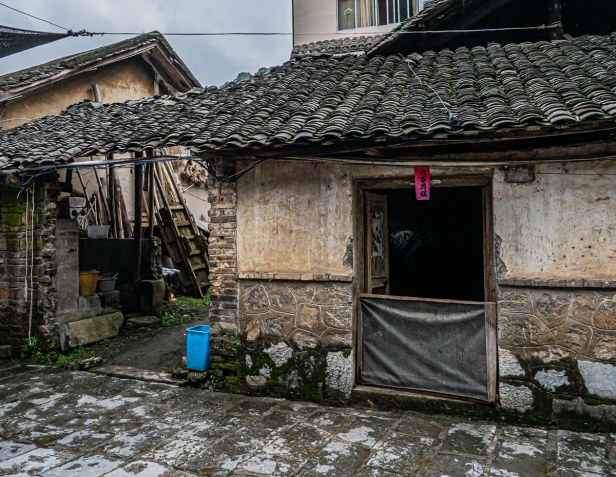
It has existed for over 800 years with the river as its front door and main highway. Most of the ancient houses were constructed during the Qing Dynasty dating as far back as the mid 1600’s and on into the early 1900’s, and with its cobble stone streets and narrow alleys the whole town exudes a kind of shabby grounded timeless charm. People keep to the old ways; they live in stone or brick houses, they leave their bright red new year portal decorations up year round, they fish in the river, and make their own rice wine. Well, and have electricity and cell phones and motorcycles too.


We catch glimpses of interiors showing simple lived-in homes. The people of Fu Li live in close-knit community leaving their doors wide open.




Fu Li is also known as Chinese Painted Fan Town, and is equally well known for scroll paintings. It’s here that there are several workshops where traditional painted fans are created by hand from local tissue paper and the bamboo that grows by the river. We stop for a demonstration,
which I find fascinating but couldn’t even begin to describe how they do it. The fans come in many sizes, the bigger ones being used as wall decorations. They are hand-painted with images of the local landscape and calligraphy. Most of the people of Fu Li are involved in this ancient craft and the fans are shipped all over China.
There’s a treed open space where people gather, little hole-in-the-wall shops selling clothing, or pottery,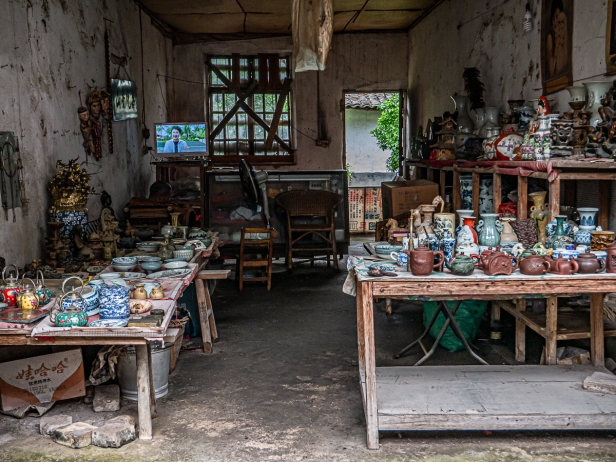
several shops selling exquisite hand-painted traditional Chinese scroll paintings,
and alleys leading to mysterious places that my ever curious self would like to explore.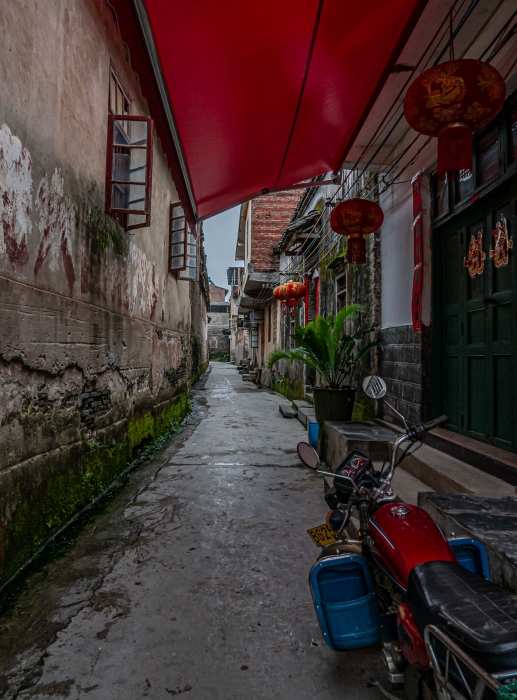
A new town has developed naturally along the main road that now connects Fu Li with the rest of China, but it is the old town that has all the charm, and a chance to catch a glimpse of a more traditional way of life.

In Yangshuo we experienced so much – stunning scenery, cycling through the rice fields, a boat trip down the river, climbing hills for the spectacular views, exploring the town, and visiting the tea plantation and Fu Li village. It will always be one of the highlights of this trip for me. I wouldn’t have missed it for all the tea in China!
Next post: Impressions Sanjie Liu: a performance ON the river, a cast of hundreds in the traditional clothing of all the ethnic minorities of the area, huge glowing moons coming down from the sky, people walking on water, hundreds of choreographed bamboo rafts, and much more. When the Chinese put on a show they really put on a show!
All words and images by Alison Louise Armstrong unless otherwise noted
© Alison Louise Armstrong and Adventures in Wonderland – a pilgrimage of the heart, 2010-2019.

Wonderful memories!
LikeLiked by 1 person
Thanks so much Mary. It really was an amazing time.
Alison
LikeLike
Oh the places you’ve been….
(love the legend of how tea came about!)
LikeLiked by 1 person
Yes, I get around a bit 🙂
I love these old legends too. It always amazes me how people discover things like this, things we’ve taken for granted for hundreds of years.
Alison
LikeLiked by 1 person
Thanks for a different insight to China! Your images are INSANELY wonderful 😊
LikeLiked by 1 person
Thanks so much Pam. China is a fascinating country, and definitely worth a visit. Not all of the trip was OTT wonderful, but that’s travel isn’t it? And there were more than enough amazing highlights to make it worthwhile.
Alison
LikeLiked by 1 person
agreed on not everything being OTT for sure. many non OTT experiences had. haha.
LikeLiked by 1 person
Chuckle. Yes, definitely lol
LikeLiked by 1 person
What did you make of the tea tasting, then? I’m a non tea drinker but still of the opinion that there must be something to it, after all these years! Did you have a favourite? The landscape is stunning. 🙂 🙂
LikeLiked by 1 person
Ha. I didn’t say anything about the tea tasting because I can’t remember more than this: we went to a tea tasting in Xi’an I think it was, and then this one at the plantation in Yangshuo, and both times nothing stood out for me. It was all tiny glasses with no black tea, and no milk and honey the way I like it 🙂 Every variety was hot, drinkable, and unmemorable.
Yeah, the landscape – some of the best I’ve seen anywhere.
Alison
LikeLike
You’re not going to convert me that way- I hate it with milk and sugar. Black with lemon, if at all 🙂 🙂
LikeLiked by 1 person
But but but . . . . you’re British!
LikeLike
With Polish genes 🙂 🙂
LikeLiked by 1 person
Oh of course. I forgot . . .
LikeLiked by 1 person
What a wonderful experience in a beautiful setting. I can see why you enjoyed this part of the trip. Amazing pictures as always.
LikeLiked by 1 person
Thanks so much Darlene. The whole Yangshuo area is really wonderful. So glad we went there.
Alison
LikeLiked by 1 person
Alison, I can see why this was one of your highlights of China.I thought the tea plantations in Sri Lanka were incredibly scenic, but these are even more amazing. I love those larger, rounded bushes sprinkled through the plantation…are they tea too? Cool that you got to see what the tea plucking is like. I’m with you on being served a cup of hot water with the tea bag on the side…drives me crazy. Your photos of the plantation and the town are all stunning.
LikeLiked by 1 person
Thanks so much Caroline. As far as I can remember the rounder bushes are a tree that produces flowers that are used to make a flower tea. Couldn’t find out any more than that.
It’s such a beautiful and interesting area. I could have done a whole lot more exploring!
Alison
LikeLiked by 1 person
More than once I’ve completely embarrassed my wife by sending back a pot of tea that had only lukewarm water. On return visits to a guilty restaurant it’s always, “don’t order the tea!”
Did you feel safe wandering around those backstreets? Did you have company or were you going solo on your little photo excursions?
LikeLiked by 1 person
I send back tea if it’s not made properly. I have even been known to give instructions 🙂
I was solo on my wanderings around the back streets and always felt completely safe. I’m not sure I’d have wandered along down some of those alleys after dark, but think I probably would have been safe anyway. It’s our equivalent of a suburban family neighbourhood with close knit community.
Alison
LikeLiked by 1 person
Wonderful commentary and photos Alison! I’ve learned a lot about tea now! I always love photos of people and you certainly have a great collection here!
LikeLiked by 2 people
Thank you so much Michael. I so enjoy photographing the people of the places I travel to. I can’t say that that’s what it’s all about for me since I love nature and landscapes and wildlife too, but it’s probably the people that are the most important.
Alison
LikeLiked by 2 people
Actually, I didn’t read anything. But see the amazing pictures. Good!
LikeLiked by 2 people
Thank you so much. It’s such a beautiful place!
Alison
LikeLike
Great opening story ~ sets the mood both far in the past and then you complete the full feeling of the tea culture in China with your incredible photos. I see the photos of the tea pickers, and within their eyes lies the experience of which leaves are perfect for picking and which are not… and with a good cup of tea you can enjoy the beautiful scenery all around 🙂
LikeLiked by 1 person
Thanks so much Randall. I loved the tea plantation. We went to quite a few cities in China (with good reason) so it was lovely to be in the countryside again. I think you are right about the tea pickers – they are so experienced that it probably (hopefully) becomes a meditation for them. Beautiful scenery indeed.
Alison
LikeLike
Although Indonesia produces some of the best coffee beans in the world, I’m more of a tea person, thanks to my mom who always made me a cup of tea to help me focus on studying at night. Long after I left my parents house and live on my own I still continue the tradition of drinking tea. However, I have never seen the process of tea making, right from plucking the tea leaves. It’s so cool that you’ve got to try that in a country where the tree originates from.
We almost stayed in Yangshuo on our trip to southern China back in 2012. But James suggested a smaller town called Xingping a few hours away from the former. I remember the walk along the river was quite nice, but weather-wise it was always cloudy.
LikeLiked by 1 person
I loved going to the tea plantation. Like you I didn’t know the process at all so it was interesting to learn where it comes from and how it’s made. And of course who wouldn’t like to be in that stunning landscape. So beautiful.
I came across Xingping as one of the worthwhile Yangshuo County villages to visit while I was researching for Fu Li. Too bad about the weather. We also had a lot of grey days, and on the day we cycled the rice fields it poured down rain for the last 10-15 minutes of our tour. Overall we didn’t get that many sunny days while there – it seems everywhere we went it was grey. The Great Wall was completely fogged in which is why I haven’t written about it.
Alison
LikeLike
Thank you for bringing to life a place we’ve never been to through your colorful, vivid stories and photos! Did you know where the tradition of pouring the milk into the cup first and then adding the tea comes from? It turns out that when the British tried to find out from the Chinese how to make porcelain (another invention we have to thank the Chinese for, alongside tea and silk, like you said), the Chinese didn’t want to part with that information. So the early attempts of the British at porcelain teacups ended up being… less than optimal; when you poured hot water into those early teacups, they would crack. What to do? What could you pour in first to take the “sting” out of the hot water being poured? Enter milk! Over time, the British perfected the porcelain making process, but the taste for the milk-in-tea-first remained 🙂
LikeLiked by 1 person
Thank you so much for your kind words. And thank you for sharing the origin of putting the milk in first! I love hearing stories like this.
Alison
LikeLiked by 1 person
I am overwhelmed! And this makes me want to go to China. 🙂 You’ve outdone yourself, and the processing complements the images so well, e.g. the desaturated dark colors in the tasting room photos. Your candid shots of people are worthy of any professionally trained photojournalist. The back alley and street life images are superb.
After drinking tea for years, the experience of picking tea leaves on a plantation must have been a high point – now that’s first-hand education! 😉 And I learned something – I knew green, black and oolongs come from the same plant but never realized black tea was fermented in order to retain flavor (and prevent mold, I bet) for long trips by ship to foreign ports – makes sense!
I’m glad you walked “deeper into town” to find ordinary life, like the joyful singing in the People’s Park. The more I see, the more I think these are scenes I might see myself next year when I go to Vietnam. Karst mountains, lively markets, etc. And maybe a place like Fu Li. I’m curious about your camera lens – do you use a zoom lens or a prime? I assume you keep your camera gear light so maybe you’ve found a really good small camera that doesn’t require too much fussing.
LikeLiked by 1 person
Thank you so much Lynn! I so appreciate your assessment. I do believe I’m getting better at processing, and perhaps a bit more confident with the people shots – always learning.
I also learned a lot about tea that I didn’t know before from that visit to a tea plantation. And of course the setting was beautiful so worth visiting just for that.
You will definitely see such scenes (markets, karst mountains, villages) in Vietnam.
I have a Panasonic mirrorless (G85 I think) and 2 lenses – 12-60 and 45-200. The camera has a micro four thirds sensor which I find a bit limiting. It’s not so good in low light. Apparently Panasonic will be coming out with a full-frame mirrorless next year so I see an upgrade in my future 🙂
Alison
LikeLike
Smaller cameras that do a lot are a good thing, right? 😉 I use an Olympus, which I love for many reasons but, like the Lumix’s, it isn’t full frame. I looked up the Panasonic full-frame mirrorless – it’s out now, but it’s a bigger camera, costs over $2,000 and uses different lenses. It does sound great. I’ve become attached to some of the Olympus lenses. It would be hard to change to a different system (the lenses I use work on Lumix’s but not on the new full-frame ones). It’s so complicated. Just give us a small, light, super-tough, weather-resistant, camera with excellent image stabilization and low-light performance that takes all the lenses we have now. 🙂
LikeLiked by 1 person
Yes, exactly!
LikeLiked by 1 person
I have followed your blog for a few years now and have always enjoyed your posts, and I particularly love your images. My travel photographs rarely reach your quality – so I am shamelessly asking if there any tips / secrets you could share?
LikeLiked by 1 person
Thank you so much for your kind words, and for following the blog!
Re photography: do you do any post editing? Most of my photographs are quick travel snapshots (especially the ones of people) and it is in editing the photos that they come alive. It’s in the editing that I frame the photo and give it depth, and adjust the colours to look like what I actually saw.
I’m fairly (though not totally) confident about photographing people, and the less they are aware of it the better as I like candid shots. People mostly don’t mind. In more years travelling than I can remember I’ve only twice upset someone by taking their photo and have deleted it immediately. Sometimes it’s really fun to interact with people to get the candid shot even when they know you’re taking it. It’s a great way to break the ice with people even if you don’t speak the language.
Re landscapes – I don’t think I’m actually that good at landscape photography. Both framing and depth of field are important I think.
That’s about it. If you have more questions feel free to ask.
Cheers, Alison
LikeLike
Wonderful photographs. Thank you for showing me a country that I don’t suppose I’ll ever visit! I look forward to the next post.
LikeLiked by 1 person
Thank you so much Chris. It’s been a long, slow, and rewarding process sharing my experiences of China. I’m so glad you’re enjoying it.
New post coming soon!
Alison
LikeLike
Wonderful photos and description of your discovery of this part of China. It seems so all encompassing and yet I am sure it just touches the surface of what there is to be discovered. I really love all the street photography which tells the story of daily life.
Peta
LikeLiked by 1 person
Thank you so much Peta. I think street photography is my favourite since I’m most interested in getting at least some feeling of what the people are like, and how life is lived in the places I visit.
This visit to China definitely just touched the surface. I’d love to go back and explore more of the rural regions – get out into those tiny villages far from anywhere. I think it would be fascinating.
Alison
LikeLike
Intriguing legend of the discovery/invention of tea and silk. Your photos, as I seem to repeat myself, are Nat. Geo material. Fabulous!
LikeLiked by 1 person
Thanks so much Sue. I loved this region of China. Who wouldn’t with that landscape! And I always love capturing the ordinary people doing ordinary things – somehow captures the reality of a place for me.
I really enjoy discovering the origins of the things we take for granted. I guess it’s one of the things I like so much about doing this blog – it “forces” me to research things I never would have thought to inquire about. Like tea and silk 🙂
Alison
LikeLiked by 1 person
I love all those legends of how things came into being. Who cares if they’re true or not! And I love all your photos of street life and interiors. (How lucky to get glimpses of inside). To me, that’s what travel is all about. The ordinary stuff. Although China does seem quite extraordinary.
LikeLiked by 1 person
Thanks so much Tracey. I feel the same way about the legends! And I think there must be a grain of truth to them.
What I said to Sue about the people – I love the everyday reality, and to me too that’s what travel is about.
China is amazing! Both extraordinary and ordinary.
Alison
LikeLike
I’m convinced after your last two posts that I had way too little time in Yangshuo! I would have loved to go into the tea fields as you all did – very cool! Even West Street looks better in your photos! 🙂
LikeLiked by 1 person
I could have used more time in Yangshuo too. I’d have loved to do some hiking in the area, and some more cycling. It’s a pretty amazing place. And the tea fields were wonderful. Also I’d like to have gone to the Longji rice terraces which are only about 2.5 hours from Yangshuo and I don’t know why it wasn’t included in the tour, or at least added as an optional extra.
Alison
LikeLiked by 1 person
This is such an interesting story. I have always wanted to go to China and your beautiful photographs have inspired me to start planning a trip! Thank you for sharing.
LikeLiked by 1 person
Thank you so much Adia, and you’re welcome! I’m glad you’re inspired to go to China. It’s an amazing and diverse country – lots to see and do there.
Alison
LikeLike
making this much more
grateful for this simple
cup of tea 🙂
LikeLiked by 1 person
Thank you David.
So much enjoyed
discovering the origins
of the tea
I drink every day 🙂
Alison
LikeLike
Aah aren’t we grateful for those British missionaries who smuggled some of those bushes into India! Yangshuo appears much nicer than I expected and that setting is truly beautiful. This series is making me nostalgic for China Alison.
LikeLiked by 1 person
So that’s how tea got to India! And then to the UK, and the rest is history. Well done those British smugglers – for tea in Britain, and especially for Indian chai. I think chai is one of my favourite things about India. We’re going back (for the fourth time!) in February – to sit with one of our favourite teachers in Rishikesh for a month. We did the same early this year and I’ve yet to post about it. I’ll get to it eventually.
But back to China – it’s a remarkable country, and Yangshuo was one of the highlights. Perhaps you’ll get back one day.
Alison
LikeLike
oh my goodness, fabulous photos! What a richness, what a diversity China offers! We had a similar tea plantation, tasting room experience in Ooty in India. So fascinating! My dad always used to say that tea was the answer to everything: warms you up if you’re cold, cools you down if you’re hot, calms you if over-excited, and wakes you up if you’re sleepy! So English! 😉
LikeLiked by 1 person
Thank you so much Danila! China is fascinating. It was a pretty amazing trip. What your dad said about tea – exactly right! And yes, so English.
Alison
LikeLike